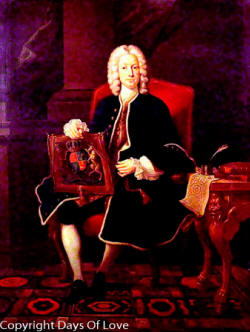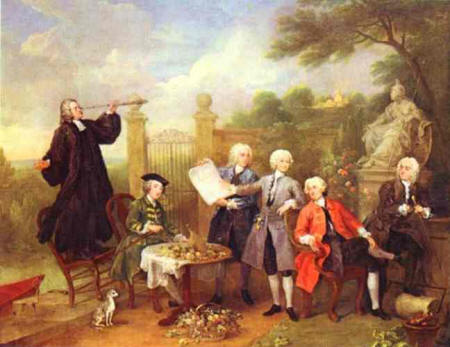

Partner Stephen Fox, Francesco Algarotti
Queer Places:
Westminster School, Little Dean's Yard, Great Smith St, Westminster, London SW1P 3PF, Regno Unito
31 Old Burlington St, Mayfair, London W1S, Regno Unito
6 St James's Square, St. James's, London SW1Y 4JU, UK
Ickworth House, 16 Dairy Cottages, Bury Saint Edmunds IP29 5QE, Regno Unito
St Mary, Ickworth, Bury Saint Edmunds IP29, Regno Unito
 John
Hervey, 2nd Baron Hervey, PC (13 October 1696 – 5 August 1743) was an English
courtier and political writer and memoirist who was the eldest son of John
Hervey, 1st Earl of Bristol, by his second wife, Elizabeth. John Hervey was known as
Lord Hervey from 1723, upon the death of his elder half-brother, Carr, the
only son of his father's first wife, Isabella, but Lord Hervey never became
Earl of Bristol, as he predeceased his father. He is portrayed as Lord Fanny
in Alexander Pope's Miscellanies (1727-28) and The Dunciad (1728), and as
Sporus in Pope's Epistle to Dr Arbuthnot (1735). Martin C. Battestin explains
that John, Lord Hervey was the original of Beau Didapper in
Henry Fielding's Joseph Andrews (1742),
suggesting that Hervey is also memorialized in Pope's "Epistle to Arbuthnot"
as "Sporus, that "mere-white Curd of Ass's milk... This painted Child of Dirt
that stinks and stings."
John
Hervey, 2nd Baron Hervey, PC (13 October 1696 – 5 August 1743) was an English
courtier and political writer and memoirist who was the eldest son of John
Hervey, 1st Earl of Bristol, by his second wife, Elizabeth. John Hervey was known as
Lord Hervey from 1723, upon the death of his elder half-brother, Carr, the
only son of his father's first wife, Isabella, but Lord Hervey never became
Earl of Bristol, as he predeceased his father. He is portrayed as Lord Fanny
in Alexander Pope's Miscellanies (1727-28) and The Dunciad (1728), and as
Sporus in Pope's Epistle to Dr Arbuthnot (1735). Martin C. Battestin explains
that John, Lord Hervey was the original of Beau Didapper in
Henry Fielding's Joseph Andrews (1742),
suggesting that Hervey is also memorialized in Pope's "Epistle to Arbuthnot"
as "Sporus, that "mere-white Curd of Ass's milk... This painted Child of Dirt
that stinks and stings."
In Epistle to Dr Arbuthnot (1734) Alexander Pope descants upon Lord Hervey, an eighteenth-century courtier whose ambiguous persona excited comment. Now high, now low, now master up, now miss, And he himself one vile antithesis. Amphibious thing! that acting either part, The trifling head, or the corrupted heart! Fop at the toilet, flatt’rer at the board, Now trips a lady, and now struts a lord. Lady Mary Wortley Montagu remarked that ‘this world consists of men, women and Herveys’. Lord Hervey himself was the model for Miss Fanny in Henry Fielding’s Shamela (1741). One of his political opponents, William Pulteney, addressed him as ‘pretty sir’ in a pamphlet and added that he ‘was such a delicate hermaphrodite … you know that he is a lady himself; or at least such a nice composition of the two sexes, that it is difficult to distinguish which is more predominant’.
Hervey was educated at Westminster School and at Clare College, Cambridge, where he took his M.A. degree in 1715.[1] His father then sent him to Paris in 1716, and thence to Hanover to pay court to George I.

Lord Hervey and His Friends,
William Hogarth,
Date: c.1738 - c.1739. Stephen Fox and his brother John flank John Hervey, along
with their friends Thomas Winnington, M.P. and Charles Spencer, 3rd Duke of
Marlborough, a political crony. The parson, Dr. Middleton, who had been
seeking favors from Hervey for some time, looks over the prospect, but in
doing so, he overlooks the affectation around him.
He was a frequent visitor at the court of the Prince and Princess of Wales at Richmond, and in 1720 he married Mary Lepell, daughter of Nicholas Lepell, who was one of the Princess's ladies-in-waiting, and a great court beauty. In 1723 John's elder half-brother Carr died, whereby he became heir apparent to the Earldom of Bristol with the courtesy title of Lord Hervey. In 1725 he was elected M.P. for Bury St Edmunds.
Hervey had been at one time on very friendly terms with Frederick, Prince of Wales, but in about 1723 they quarrelled, apparently because they were rivals for the affection of Anne Vane. These differences probably account for the scathing picture he draws of the Prince's callous conduct. Hervey had been hesitating between William Pulteney (afterwards earl of Bath) and Robert Walpole, but in 1730 he definitely took sides with Walpole, of whom he was thenceforward a faithful adherent. He was assumed by Pulteney to be the author of Sedition and Defamation display'd, with a Dedication to the patrons of The Craftsman (1731). Pulteney, who, up to this time, had been a firm friend of Hervey, replied with A Proper Reply to a late Scurrilous Libel, and the quarrel resulted in a duel from which Hervey narrowly escaped with his life.
Hervey is said to have denied the authorship of both the pamphlet and its dedication, but a note on the manuscript at Ickworth, apparently in his own hand, states that he wrote the latter. He was able to render valuable service to Walpole from his influence with the Queen. Through him the minister governed Queen Caroline and indirectly George II. Hervey was vice-chamberlain in the royal household and a member of the Privy Council. In 1733 he was called to the House of Lords by writ of acceleration in his father's Barony. He was then elected a governor of the Foundling Hospital prior to its foundation in 1739.[2] In spite of repeated requests he received no further preferment until after 1740, when he became Lord Privy Seal.
After the fall of Sir Robert Walpole he was dismissed (July 1742) from his office. An excellent political pamphlet, Miscellaneous Thoughts on the present Posture of Foreign and Domestic Affairs, shows that he still retained his mental vigour, but he was liable to epilepsy, and his weak appearance and rigid diet were a constant source of ridicule to his enemies. He predeceased his father, but three of his sons became successively Earls of Bristol.
Hervey married Mary Lepell (1700–1768) on 21 April 1720. They had eight children:
1. The Hon. Mary Hervey (c. 1720–), married 1745 George Fitzgerald, of Turlough
2. George William Hervey, 2nd Earl of Bristol (1721–1775), unmarried
3. The Hon. Lepell Hervey (15 April 1723 – 11 May 1780), married 1743 Constantine John Phipps, 1st Baron Mulgrave, leaving issue
4. Augustus John Hervey, 3rd Earl of Bristol (1724–1779), died without legitimate issue
5. Frederick Augustus Hervey, 4th Earl of Bristol (1730–1803), married 1752 Elizabeth Davers, had issue
6. General Hon. William Hervey (13 May 1732 – 1815), unmarried
7. The Hon. Amelia Caroline Nassau Hervey (1734–1814), unmarried
8. The Hon. Caroline Hervey (1736–1819), unmarried
Hervey was bisexual.[4] He had an affair with Anne Vane, and possibly with Lady Mary Wortley Montagu and Princess Caroline. He lived with Stephen Fox often during the decade after he followed him to Italy in 1728. He wrote passionate love letters to Francesco Algarotti, whom he first met in 1736. He may have had a sexual affair with Prince Frederick before their friendship dissolved. He was in fact denounced as a sexually ambiguous figure in his time most notably by William Pulteney, then leader of the Opposition and as cited above, by Alexander Pope in his "Sporus" portrait: "Let Sporus tremble/What that thing of silk...His wit all seesaw between that and this/Now high, now low, now master up, now miss/And he himself one vile antithesis...". He was also attracted to Henry Fox before his affair with Stephen Fox.[5][6]
Hervey loved his friends and was happy to celebrate that love in letters that are steamy and suggestive. "You have left some such remembrances behind you," he wrote to Fox, "that I assure you... you are not in the least Danger of being forgotten. The favours I have received at Your Honour's Hands are of such a nature that tho' the impression might wear out of my Mind, yet they are written in such lasting characters upon every Limb, that 'tis impossible for me to look on a Leg or an Arm without having my Memory refresh'd." Or: "I have often thought, if any very idle Body had Curiosity enough to intercept & examine my Letters, they would certainly conclude they came from a Mistress than a Friend." And: "I love you & love you more than I thought I could love any thing."
My published books: